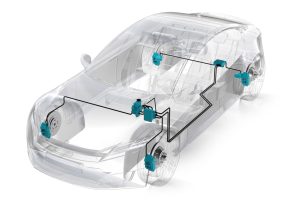Driving safety is a top priority for all motorists, and advancements in automotive technology continue to play a crucial role in enhancing safety on the roads. One such innovation is solar electric brakes, a technology that harnesses solar energy to improve braking performance. This article explores how solar electric brakes work, their impact on driving safety, and their potential benefits for modern vehicles. How Solar Electric Brakes Improve Driving Safety
Introduction to Solar Electric Brakes
Solar electric brakes are an advanced braking system that integrates solar power with traditional braking mechanisms. By utilizing solar energy, these brakes offer a more efficient and reliable way to enhance vehicle safety. The technology involves solar panels mounted on the vehicle, which convert sunlight into electrical energy used to activate the braking system.
Components of Solar Electric Brakes
Solar Panels: Installed on the vehicle to capture sunlight and convert it into electrical energy.
Photovoltaic Cells: Embedded in the solar panels, these cells are responsible for converting solar energy into electricity.
Energy Storage System: A rechargeable battery or capacitor that stores the generated electricity for use when braking is required.
Electric Braking System: Uses the stored energy to activate the brakes, ensuring effective braking performance.
How Solar Electric Brakes Work
Solar electric brakes operate by capturing sunlight through solar panels mounted on the vehicle. The photovoltaic cells in the panels convert sunlight into electrical energy, which is then stored in an energy storage system. When the driver engages the brakes, the stored energy is used to activate the braking system, providing a more efficient and responsive braking performance.

Benefits for Driving Safety
Solar electric brakes offer several advantages that contribute to improved driving safety. These benefits include enhanced braking performance, increased reliability, and better response times.
Enhanced Braking Performance
One of the primary benefits of solar electric brakes is their ability to enhance braking performance. By utilizing solar power to activate the brakes, these systems ensure that braking is more consistent and responsive. This enhanced performance reduces the likelihood of brake fade and ensures reliable stopping power, especially during emergency situations.
Increased Reliability
Traditional braking systems can experience issues such as wear and tear, leading to reduced reliability over time. Solar electric brakes, however, use electrical energy generated by solar panels, which can result in fewer mechanical components subject to wear. This increased reliability means that the braking system is less likely to fail, providing added safety for drivers and passengers.
Improved Response Times
Solar electric brakes can offer faster response times compared to traditional braking systems. The use of stored electrical energy allows for quicker activation of the brakes, reducing the time it takes to come to a complete stop. This improved response time can be crucial in avoiding collisions and reacting to sudden changes in traffic conditions.
Compatibility with Other Safety Systems
Solar electric brakes can be integrated with existing vehicle safety technologies to further enhance overall driving safety. These integrations include compatibility with advanced driver assistance systems (ADAS) and autonomous driving technologies.
Integration with Advanced Driver Assistance Systems (ADAS)
ADAS technologies, such as lane-keeping assistance, adaptive cruise control, and automatic emergency braking, can work in conjunction with solar electric brakes. The combination of these systems ensures a comprehensive approach to driving safety, with solar electric brakes providing additional support by enhancing braking performance and response times.
Support for Autonomous Driving Technologies
As autonomous driving technologies become more prevalent, solar electric brakes offer a valuable addition to these systems. The reliable and efficient braking performance provided by solar electric brakes complements the capabilities of autonomous vehicles, ensuring that braking is both precise and effective in various driving conditions.
Addressing Challenges and Future Developments
While solar electric brakes offer significant safety benefits, there are challenges associated with their implementation. Addressing these challenges and exploring future developments will be crucial for maximizing the potential of this technology.
Challenges in Implementation
One challenge in implementing solar electric brakes is the need for sufficient sunlight exposure to generate adequate electrical energy. Vehicles with limited access to sunlight, such as those parked in shaded areas, may experience reduced performance. Additionally, integrating solar electric brakes with existing vehicle systems can be complex and may require specialized expertise.
Future Developments
Ongoing advancements in solar technology and automotive engineering are expected to address some of these challenges. Improvements in solar panel efficiency, energy storage solutions, and integration techniques will enhance the performance and practicality of solar electric brakes. As technology continues to evolve, solar electric brakes are likely to become more accessible and effective in improving driving safety.
Solar electric brakes represent a significant advancement in automotive safety technology, offering enhanced braking performance, increased reliability, and improved response times. By harnessing solar energy, these brakes provide a more efficient and reliable braking solution, contributing to overall driving safety. As technology continues to advance, solar electric brakes will play an increasingly important role in ensuring safer and more sustainable transportation. Embracing these innovations will help shape the future of automotive safety and contribute to a more secure driving experience for all.


